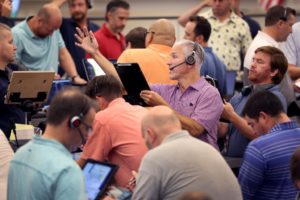The US financial markets have kicked off the fourth quarter licking the last remnants of a spiked punch bowl, courtesy of the Federal Reserve. It turns out that the beverages were laced with so much quantitative easing that traders are reminiscing about the good old days of July 2022 and buying stocks as if Wall Street were flooded with easy money. So, is this the beginning of a bull market, or is it another dead cat bounce à la July? Understanding why everyone is suddenly so ebullient might offer an answer.
Begging for a Federal Reserve Pivot
 The Reserve Bank of Australia (RBA) surprised global investors in the wee hours of Oct. 4 by pulling the trigger on a tepid quarter-point rate hike. The Australian organization bucked the worldwide trend of hawkish tightening, choosing to increase the benchmark rate to 2.6% instead. Gov. Philip Lowe reiterated his bank’s tightening efforts, with the chief objective being to crush inflation. While the Aussie dollar slumped on the news, equities surged in the Land Down Under, as the S&P/ASX 200 rallied nearly 4%.
The Reserve Bank of Australia (RBA) surprised global investors in the wee hours of Oct. 4 by pulling the trigger on a tepid quarter-point rate hike. The Australian organization bucked the worldwide trend of hawkish tightening, choosing to increase the benchmark rate to 2.6% instead. Gov. Philip Lowe reiterated his bank’s tightening efforts, with the chief objective being to crush inflation. While the Aussie dollar slumped on the news, equities surged in the Land Down Under, as the S&P/ASX 200 rallied nearly 4%.
This comes about one week after the Bank of England (BoE) blinked by suspending its quantitative tightening campaign and buying billions of dollars worth of bonds. The British central bank wanted to save the gilts and bail out Prime Minister Liz Truss. The results were yields tumbling, the pound climbing against the greenback, and the Conservatives tergiversating on their fiscal stimulus package.
In addition, the United Nations Conference on Trade and Development (UNCTAD) urged the Fed and its colleagues to stop raising rates as this “excessive monetary tightening could usher in a period of stagnation and economic instability” for the world economy. “Any belief that they (central banks) will be able to bring down prices by relying on higher interest rates without generating a recession is, the report suggests, an imprudent gamble,” the UN agency stated.
All three developments provided investors with a new lease on life. Whether it is out of desperation or a realistic assessment of how central banks behave, investors are buying all the stonks and HODLing, as the cool kids on Robinhood and Wall Street Bets like to say. But are they setting themselves up for disappointment? When traders try to return their accounts to break even, anything goes, it seems.
A Junkie’s Paradise
In the first two trading sessions of the fourth quarter, the Dow Jones Industrial Average added more than 1,000 points, the S&P 500 picked up close to 6%, and the Nasdaq Composite Index rallied about 700 points. Gold topped $1,700, silver surpassed $21, Bitcoin flirted with $21,000, and US crude oil exceeded $86 per barrel. In other words, the bulls were feasting on bear carcasses.

(Photo by Scott Olson/Getty Images)
But are these gains based on strong fundamentals? Unlikely. Investors are like junkies, hoping to obtain their next fix and scratch the monkey on their backs. They have ostensibly forgotten that inflation is running north of 8%, and nearly every Fed official is operating from the same “higher for longer” playbook without any deviation. And yet, the futures market is suggesting that rate cuts are coming sometime next year to rescue the economy from the ashes of a recession.
If the RBA executed a lower-than-expected rate hike and the BoE paused QT when inflation is still elevated and sticky, why would the Eccles Building not intervene if the housing market craters or Treasurys crumble? This is what investors, from the institutional Wall Street bros to the retail Robinhood men in tights, are asking. Their conclusion is to dive back into stocks and launch a year-end rally. In a way, there is some method to this madness because what else is there to price in at this point in 2022? The New York Stock Exchange knows the fed funds rate will touch 4.6% in 2023, and Chair Jerome Powell famously uttered during his post-Federal Open Market Committee (FOMC) policy meeting that “it will become appropriate to slow the pace of increases.” If there is one thing investors appreciate, it is a modicum of certainty, something that was evident during the pandemic-era stock market boom: unlimited quantitative easing and artificially low interest rates for an extended period.
Everything Is Broken
In the early days of the COVID-19 public health crisis, people outside of 11 Wall Street were scratching their heads and wondering why markets were soaring when millions were unemployed, thousands were dying every day, and the economy was shut down. As Liberty Nation reported, the Federal Reserve and Congress flooded the country with trillions of dollars in fiscal and monetary stimulus, which flowed into the investment ocean. When the US central bank started to turn off the spigot, everything began breaking, from the bond market to the real estate sector to ostensibly labor. There is now hope that the international marketplace can forget this morose state by ingesting a dose of soma and living in a world where stocks travel only higher. Be it euphoria or delusion, this is a unique era.

